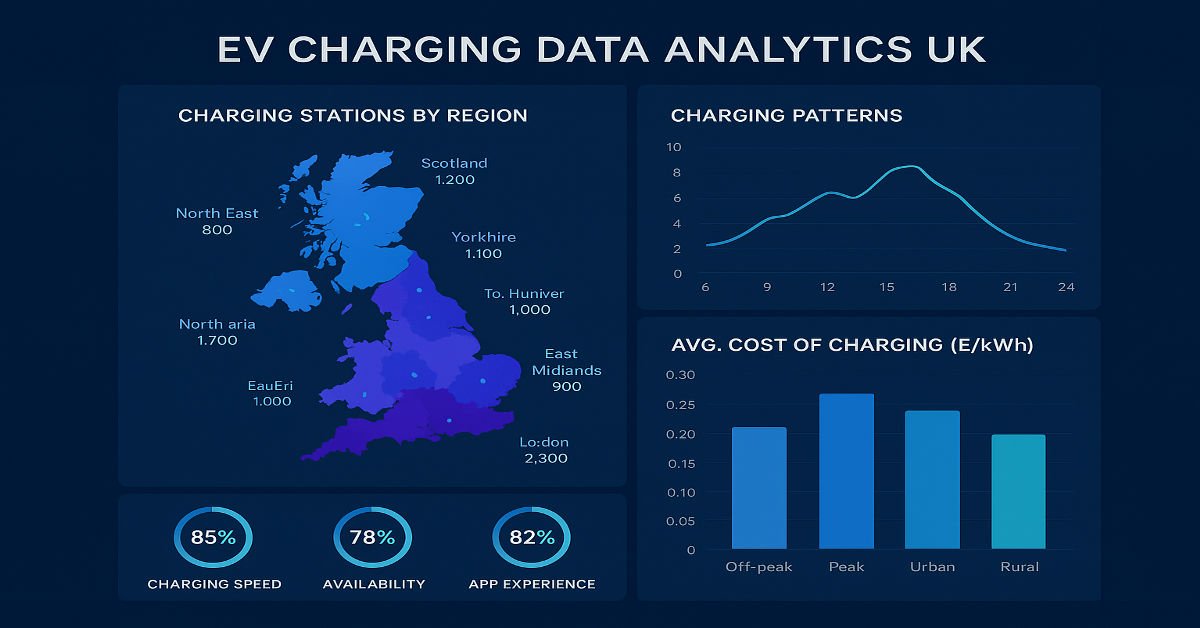Introduction
The rise of electric vehicles (EVs) in the United Kingdom has brought not only cleaner transportation but also a flood of valuable data. Every time an EV charges, it generates information about energy usage, charging time, cost, and grid performance. This growing field of EV charging data analytics is transforming how the UK manages its charging networks, optimizes grid efficiency, and enhances driver experience.
In this guide, we’ll explore how data analytics drives the UK’s EV infrastructure, how companies use data for innovation, and why it’s essential for the future of sustainable transport.
What Is EV Charging Data Analytics?
EV charging data analytics refers to the collection, processing, and analysis of data from public and private charging networks. This includes information such as:
-
Charging duration and frequency
-
Energy consumption (kWh)
-
User behavior and location data
-
Charging station performance
-
Grid demand and cost efficiency
By analyzing these datasets, energy providers and mobility companies can make data-driven decisions to reduce energy costs, avoid peak load issues, and improve EV charging accessibility.
Key Benefits of EV Charging Data Analytics in the UK
| Benefit | Description |
|---|---|
| Improved Efficiency | Predicts peak usage hours and optimizes charging schedules. |
| Enhanced Grid Stability | Balances energy demand to prevent grid overload. |
| Better User Experience | Helps drivers locate available, affordable chargers in real time. |
| Cost Savings | Reduces operational and maintenance costs for charging providers. |
| Policy Development | Supports government decisions on EV incentives and infrastructure investments. |
How Data Analytics Shapes the UK EV Ecosystem
1. Smart Charging Infrastructure
EV charging analytics helps develop smart charging systems that adjust charging speed based on grid capacity. For instance, during off-peak hours, prices drop automatically, benefiting both drivers and providers.
2. Predictive Maintenance
Data identifies patterns of charger faults and maintenance needs before breakdowns occur, reducing downtime and repair costs.
3. Location Optimization
Using geographic data, companies can identify high-demand areas for new charging stations — particularly along highways, shopping centers, and residential zones.
4. Integration with Renewable Energy
Analytics supports solar and wind energy integration by matching renewable generation with EV charging demand, reducing carbon emissions and energy waste.
UK Government and Industry Initiatives
The UK government recognizes the role of data analytics in achieving its Net Zero 2050 goals. Agencies and private firms are investing in AI-powered charging management systems and open data platforms.
| Initiative / Organization | Focus Area | Impact |
|---|---|---|
| Office for Zero Emission Vehicles (OZEV) | EV data and infrastructure grants | Expanding data-sharing networks |
| National Grid ESO | Grid stability and energy balancing | Prevents overloads during peak charging |
| Zapmap & Pod Point | Charging station data tracking | Provides live analytics for users |
| Octopus Energy & Shell Recharge | Smart charging technology | Dynamic pricing and renewable integration |
The Role of AI and IoT in EV Charging Data Analytics
Modern analytics rely heavily on Artificial Intelligence (AI) and Internet of Things (IoT) sensors.
Here’s how they’re transforming the landscape:
-
AI Algorithms: Analyze vast datasets to forecast demand and optimize grid use.
-
IoT Devices: Real-time sensors monitor temperature, power flow, and charger status.
-
Cloud Platforms: Store and process data from thousands of charging points securely.
These technologies enable real-time decision-making, improving both user satisfaction and sustainability.
EV Data Analytics for Businesses
Businesses across the UK are leveraging EV charging data to optimize fleet operations and reduce costs.
| Business Sector | Data Application | Outcome |
|---|---|---|
| Fleet Operators | Analyze route efficiency & charging cost | 15–25% savings in fuel replacement |
| Retail & Hospitality | Offer charging stations to attract EV drivers | Increased customer footfall |
| Energy Providers | Balance renewable energy usage | Reduced grid congestion |
| Automakers (Nissan, Jaguar, Tesla) | Monitor vehicle performance | Improved battery life and charging speed |
Challenges in EV Charging Data Analytics
Despite the benefits, there are a few challenges:
-
Data Privacy Concerns: Protecting user location and behavior data.
-
Interoperability: Different networks use different data formats.
-
High Infrastructure Cost: Advanced analytics platforms require strong cloud and cybersecurity systems.
-
Data Accuracy: Incomplete or incorrect data can lead to poor decision-making.
The Future of EV Charging Analytics in the UK
By 2030, the UK is projected to have over 1 million public EV chargers. This will create massive data volumes that can help:
-
Predict nationwide electricity demand
-
Support AI-driven smart grid systems
-
Enable personalized charging experiences through apps
-
Improve battery recycling and sustainability metrics
As data transparency improves, collaboration between governments, automakers, and tech firms will make EV infrastructure smarter, greener, and more efficient.
Conclusion
EV charging data analytics is powering the next evolution of electric mobility in the UK. From optimizing grid performance to making charging affordable and convenient, data insights play a vital role in achieving the Net Zero 2050 vision.

1 thought on “EV Charging Data Analytics in the UK”